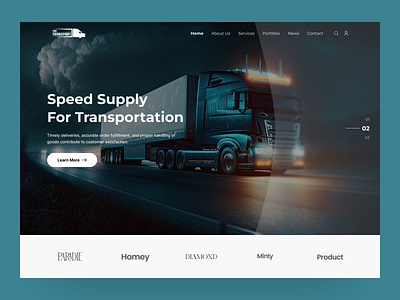Crafting Mobile-Responsive transportation web design.
Wiki Article
How Specialized Transportation Internet Style Helps Improve Customer Engagement and Conversion
By focusing on user-centric functions, these websites not only simplify navigation however likewise adjust seamlessly to different gadgets, guaranteeing access for all users. The strategic integration of visual elements and clear call-to-action prompts can substantially affect user behavior.Value of User-Centric Style
In today's electronic landscape, a user-centric style is vital for specialized transport internet systems - transportation web design. This approach prioritizes the requirements and choices of customers, boosting their total experience while browsing intricate transport solutions. By concentrating on use, access, and instinctive navigating, services can promote a sense of trust fund and dependability among customers, which is critical in the transportation industryUser-centric design involves comprehensive research study to comprehend the target audience's behaviors, motivations, and challenges. This knowledge educates the growth of functions such as streamlined reservation processes, very easy accessibility to service information, and receptive client support. Personalization can be incorporated to cater to individual user choices, leading to boosted engagement and contentment.
Implementing a user-centric layout not only improves the capability of transportation web platforms yet also enhances conversion rates. When users discover a platform very easy to navigate and responsive to their requirements, they are much more most likely to total purchases and return for future services. Inevitably, a well-executed user-centric design adds to the overall success of specialized transportation businesses by improving client loyalty and motivating repeat service.
Impact of Visual Aspects
While the functionality of a specialized transport web platform is essential, the effect of aesthetic components can not be overlooked. A well-designed aesthetic design plays a vital role in catching customer attention and assisting in information retention. Effective use color, typography, and imagery not just enhances the visual allure but likewise communicates brand identity and professionalism.Visual components, such as premium photos of transport services, can stimulate count on and integrity, urging potential clients to engage additionally. Infographics and symbols simplify complicated details, making it extra digestible. This clarity can result in reduced bounce rates and raised time invested on website, both of which declare signs of individual involvement.
In addition, a regular aesthetic power structure overviews users through the site effortlessly, making sure that essential info-- such as solution offerings, prices, and get in touch with details-- is easily accessible. This strategic arrangement assists to route possible customers towards preferred activities, such as filling in a call type or asking for a quote.

Mobile Responsiveness Benefits
The importance of aesthetic elements reaches mobile responsiveness, which is significantly essential in today's digital landscape. As more customers accessibility sites via mobile phones, a receptive layout guarantees that web content is displayed efficiently throughout numerous display sizes. This versatility not just enhances user experience but likewise significantly impacts customer involvement and conversion rates.Mobile responsiveness permits specialized transportation business to satisfy the expectations of a varied customers. Individuals are more probable to stay on a site that is very easy to browse on their smartphones or tablets, resulting in longer session durations and reduced bounce prices. A mobile-friendly design constructs credibility; clients are more likely to trust fund and involve with a business that presents itself well on all gadgets.
In addition, online search engine like Google prioritize mobile-optimized sites in their ranking algorithms. transportation web design. Companies that invest in mobile responsiveness can improve their presence and draw in more organic website traffic. This enhanced exposure can equate into greater conversion rates, as possible clients are most likely to call or book solutions through a site that operates effortlessly on their smart phones. Thus, mobile responsiveness is a vital element of effective website design in the specialized transport industry.
Streamlining Navigation Experience

A well-structured navigation experience is crucial for specialized transportation sites, as it straight affects customer engagement and satisfaction. When possible customers see these websites, they anticipate to find information promptly and successfully. A structured navigating system can considerably enhance this procedure, leading users perfectly with various solutions, prices choices, and contact info.
To achieve optimal navigating, it is crucial to classify content rationally. Making use of a clear hierarchy-- such as main and second food selections-- aids customers discern where to locate particular info without really feeling overwhelmed. Furthermore, including drop-down menus can give fast accessibility to subcategories, lessening click depth, which is vital for keeping customer attention.
In addition, a search feature permits individuals to bypass navigation altogether, accommodating those that recognize specifically what they look for. Implementing breadcrumb routes can additionally improve the user experience by supplying a visual path back to previous web pages, strengthening website structure.
Integrating mobile-friendly navigation is just as crucial, as numerous customers gain access to specialized transport sites on their smartphones. By prioritizing an intuitive and receptive design, services can ensure that their web site Bonuses effectively offers diverse individual requirements, inevitably enhancing customer interaction and conversion rates.
Incorporating Call-to-Action Strategies
Reliable call-to-action (CTA) methods are vital for leading customers towards preferred end results on specialized transport sites. These techniques not only improve customer involvement but also dramatically enhance weblink conversion prices. CTAs should be strategically put throughout the website, guaranteeing they are easily noticeable and available.
Including necessity in CTAs, such as limited-time offers or unique offers, can further motivate users to act without delay. A/B testing different CTA styles and positionings can give valuable understandings right into what resonates best with the target market.
Furthermore, making certain that CTAs are mobile-friendly is critical, as a substantial portion of users might access the site using mobile phones. transportation web design. By thoughtfully integrating these approaches, specialized transportation internet sites can efficiently lead users through the conversion Go Here channel, ultimately causing increased client involvement and successful outcomes
Conclusion
In verdict, specialized transport internet design substantially improves client interaction and conversion by prioritizing user-centric features, incorporating impactful visual aspects, and ensuring mobile responsiveness. Structured navigation experiences and well-integrated call-to-action methods further add to a smooth individual journey.Report this wiki page